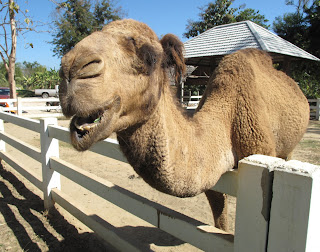 I booked my flight from India to Korea so that I could enjoy a one week layover in Thailand. So many of the staff at TCIS have visited and raved about many areas of Thailand -- from Phuket to Chiang Mai -- that I thought this would be a good opportunity to select a destination and experience it firsthand.
I booked my flight from India to Korea so that I could enjoy a one week layover in Thailand. So many of the staff at TCIS have visited and raved about many areas of Thailand -- from Phuket to Chiang Mai -- that I thought this would be a good opportunity to select a destination and experience it firsthand.
Fortunately for me, friends of mine -- Barry and his family -- moved from Perth Australia to Chiang Mai last April so I could reconnect with them and see the sights at the same time. Barry continues to work with a division of YWAM called Create International whose purpose, according to their web site, is to "communicate the message of Jesus Christ in ways that people can understand from their cultural and linguistic background, using all media tools possible". The organization is based in southern Asia since they primarily work with people groups in Asia.

 I sure appreciate Barry and Donna taking time from their regular routine to show me the behind-the-scenes view of the Chiang Mai area. Besides traveling the streets of Chiang Mai from the front seat of their car, I got to see where they live, work, go to church and taste from some great restaurants off the beaten path. It is evident the king of Thailand means a lot to the people of this country, having images of him on billboards throughout the city and even having to stand as they played Thailand's version of "God Save the King" when I went to a movie one afternoon.
I sure appreciate Barry and Donna taking time from their regular routine to show me the behind-the-scenes view of the Chiang Mai area. Besides traveling the streets of Chiang Mai from the front seat of their car, I got to see where they live, work, go to church and taste from some great restaurants off the beaten path. It is evident the king of Thailand means a lot to the people of this country, having images of him on billboards throughout the city and even having to stand as they played Thailand's version of "God Save the King" when I went to a movie one afternoon. Periodically we also visited tourist destinations, like today's visit to the most popular Buddhist temple in the area named Wat Phrathat Doi Suthep. This most important temple of Chiang Mai is located on Doi Suthep mountain, which is about nine miles of winding mountainous highway from the city. Apparently Buddhist pilgrimages regularly descend upon this temple during religious holidays. Besides the many vendors lining the streets and walkways, those making the pilgrimage encounter a 'guardian monk' statue and steep 309 step stairway that leads to the temple itself.
Periodically we also visited tourist destinations, like today's visit to the most popular Buddhist temple in the area named Wat Phrathat Doi Suthep. This most important temple of Chiang Mai is located on Doi Suthep mountain, which is about nine miles of winding mountainous highway from the city. Apparently Buddhist pilgrimages regularly descend upon this temple during religious holidays. Besides the many vendors lining the streets and walkways, those making the pilgrimage encounter a 'guardian monk' statue and steep 309 step stairway that leads to the temple itself.


Once arriving at the temple area visitors notice spectacular views of the city of Chiang Mai and well-preserved buildings covered in gold leaf and ornately decorated. Ancient Buddha relics from when the temple was originally built in the 14th century are housed in the giant golden Chedi along with beautiful murals and bells hanging along walls.






 For those who practice Buddhism there is opportunity to light incense sticks to purify and create a meditative environment as they pray either to a Buddha or try to radiate loving-kindness. There are many places in this temple area to meditate and pray, including opportunity for monks and followers to perform a water pouring ceremony -- pouring water into water.
For those who practice Buddhism there is opportunity to light incense sticks to purify and create a meditative environment as they pray either to a Buddha or try to radiate loving-kindness. There are many places in this temple area to meditate and pray, including opportunity for monks and followers to perform a water pouring ceremony -- pouring water into water.Although I appreciate their attention to the spiritual world and desire to better themselves, I wish followers of Buddha would accept they can not achieve salvation or betterment on their own. It is not a matter of hopefully one day becoming self-enlightened or awakening to the truth or conjuring up certain feelings but finding the answer in the teachings of Jesus Christ. Our Living God not only provides instruction for us through His Word (the Bible) but offers each of us opportunity for a personal, immediate, current-day relationship with Him! Consequently, the peace and sense of purpose we all desire deep within is attainable right now, through this relationship with Jesus Christ.




I keep going back to what God says in Habakkuk 2:18-20 and in Acts 4:12 whenever I see statues and rituals of this nature:
If someone carves a statue of a god, what is it worth?
What value is there in a god that teaches lies?
The one who trusts in another god worships his own creation.
He makes statues of gods that can’t speak.
How terrible it will be for the Babylonians!
They say to a wooden god, ‘Come to life!’
They say to a stone god, ‘Wake up!’
Can those gods give advice?
They are covered with gold and silver.
They can’t even breathe.
But I am in my holy temple.
Let the whole earth be silent in front of me.
Salvation is found in no one else, for there is no other name under heaven given to men by which we must be saved.
Barry mentioned something about visiting a waterfall on our way to the temple but I had no idea how beautiful it would be. A perfect place for locals to picnic and simply unwind. I know if I were to live in Chiang Mai this would be a popular destination for me along with many of the mountain hiking trails found nearby.

























